Yes. Out of the box, all DDR5 RAM will run at a slower, default JEDEC standard speed. To reach the advertised speeds (e.g., 6000 MT/s), you must enter your motherboard’s BIOS and enable the corresponding Intel XMP or AMD EXPO profile. This is a simple, one-click process. To do this, you will first need to learn how to get into BIOS on an MSI motherboard or the equivalent for your specific brand.A Definitive Guide to DDR5 RAM
DDR5 represents the latest standard in synchronous dynamic random-access memory (SDRAM) technology, offering a substantial leap in performance over its predecessor, DDR4. With a higher theoretical bandwidth, increased module capacities, and improved power management, DDR5 is engineered to meet the demands of modern computing, from high-end gaming to intensive content creation.
The core advantage of DDR5 lies in its architectural improvements. It features a dual 32-bit subchannel design per module, enhancing memory access efficiency. This, combined with higher clock speeds, allows DDR5 to feed data to today’s multi-core processors more effectively. For users with demanding workloads, this translates to faster load times, smoother multitasking, and potentially higher frame rates in cpu-intensive-games.
This guide provides a purely informational, technical breakdown of ten prominent DDR5 RAM models available. It is designed to be an authoritative resource, helping you understand the key specifications and make an informed decision based on objective data.
2025 DDR5 RAM: A Comprehensive Comparison
This table offers a direct comparison of the critical specifications for each DDR5 kit detailed in this guide. The focus is on 32GB (2x16GB) kits, which represent a balanced choice for most gaming and productivity systems.
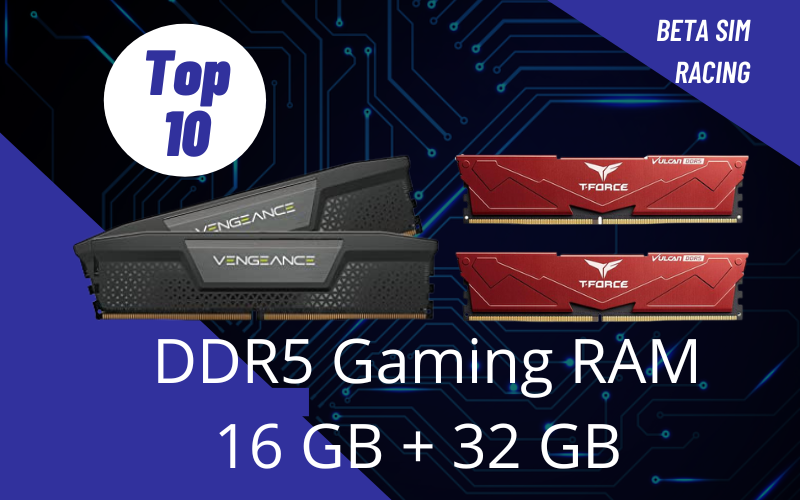
| Model | Capacity | Speed (MT/s) | CAS Latency (CL) | Timings | Voltage | RGB Lighting | Key Feature |
| TEAMGROUP T-Force Vulcan | 32GB (2x16GB) | 6000 | 30 | 30-38-38-96 | 1.35V | No | Low-profile design for maximum cooler compatibility. |
| TEAMGROUP T-Force Delta RGB | 32GB (2x16GB) | 6400 | 32 | 32-39-39-84 | 1.35V | Yes | Aggressive styling with a wide 120° RGB light bar. |
| Kingston FURY Beast | 32GB (2x16GB) | 6000 | 36 | 36-38-38 | 1.35V | No | A dependable, no-frills kit with a strong reputation. |
| CORSAIR Dominator Platinum RGB | 32GB (2x16GB) | 6200 | 36 | 36-39-39-76 | 1.30V | Yes | Premium build quality with patented DHX cooling. |
| Gigabyte AORUS Memory | 32GB (2x16GB) | 6000 | 36 | 36-36-36-76 | 1.35V | Yes | Copper-aluminum composite heatsinks. |
| Crucial Pro DDR5 | 32GB (2x16GB) | 6000 | 36 | 36-38-38 | 1.1V / 1.35V | No | Plug-and-play simplicity; supports XMP/EXPO. |
| Lexar ARES RGB DDR5 | 32GB (2x16GB) | 6400 | 32 | 32-38-38-76 | 1.40V | Yes | High-speed performance with vibrant, customizable RGB. |
| CORSAIR Vengeance DDR5 | 32GB (2x16GB) | 6000 | 30 | 30-36-36-76 | 1.40V | No | Widely considered the performance sweet spot. |
| XPG Lancer Blade RGB | 32GB (2x16GB) | 6000 | 30 | 30-40-40 | 1.35V | Yes | Low-profile RGB design for smaller builds. |
| ADATA Premier DDR5 | 16GB (1x16GB) | 4800 | 40 | 40-40-40 | 1.1V | No | JEDEC standard module for basic, non-gaming systems. |
A Detailed Analysis of 10 Key DDR5 RAM Models
The following sections provide an objective overview of each RAM kit, focusing on its technical specifications and ideal use cases.
1. TEAMGROUP T-Force Vulcan DDR5
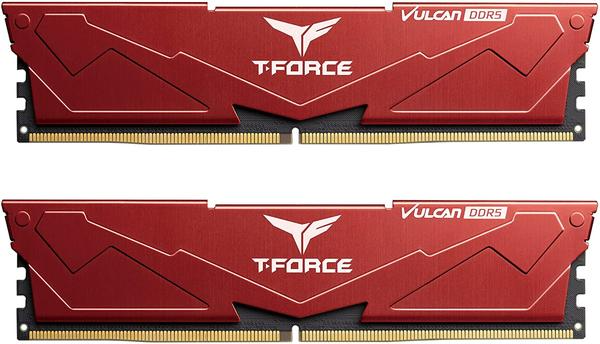
The TEAMGROUP T-Force Vulcan series is designed for users who prioritize performance and compatibility. Its key characteristic is the sleek, low-profile aluminum heat spreader. This minimalist design ensures it fits comfortably under large CPU air coolers where taller, more ornate modules might not.
This particular model, running at 6000 MT/s with a tight CAS Latency of CL30, hits a performance sweet spot that is excellent for both Intel and AMD systems. It includes an on-die Error-Correcting Code (ECC) for improved system stability and a Power Management IC (PMIC) for stable, efficient power delivery.
- Module Type: 288 Pin Unbuffered DIMM
- Performance Profile: Intel XMP 3.0 / AMD EXPO
- Heatsink: Anodized Aluminum
- Ideal Use Case: Gaming or professional builds where CPU cooler clearance is a concern.
2. TEAMGROUP T-Force Delta RGB DDR5
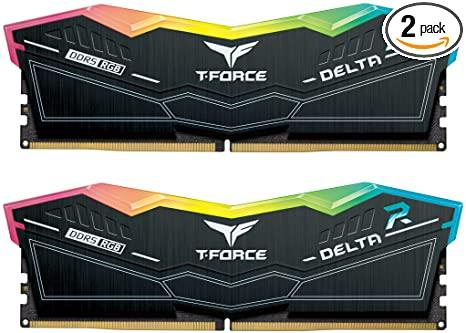
The T-Force Delta RGB is targeted at enthusiasts who want both high-speed performance and striking visual aesthetics. It is easily recognizable by its aggressive design and the 120° ultra-wide RGB light bar that provides smooth, customizable lighting.
With speeds of 6400 MT/s and a CL32 latency, this kit offers a step-up in bandwidth for users looking to maximize performance in high-end systems. Like its Vulcan counterpart, it features an on-die ECC and a strengthened PMIC. The lighting effects are compatible with major motherboard software suites like ASUS Aura Sync, Gigabyte RGB Fusion, MSI Mystic Light Sync, and ASRock Polychrome Sync.
- Module Type: 288 Pin Unbuffered DIMM
- Performance Profile: Intel XMP 3.0 / AMD EXPO
- Heatsink: Aluminum Alloy
- Ideal Use Case: High-performance gaming rigs and custom builds with a visual theme.
3. Kingston FURY Beast DDR5
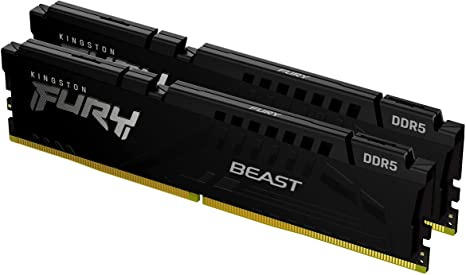
Kingston’s FURY Beast line has a long-standing reputation for reliability and solid performance. This DDR5 iteration continues that legacy, offering a plug-and-play solution for mainstream and high-performance builds. The 6000 MT/s CL36 variant represents a balanced and cost-effective option.
While it lacks the RGB lighting of more flamboyant kits, its focus is on stability. It is qualified by major motherboard manufacturers and supports Intel XMP 3.0. The low-profile heat spreader design offers good compatibility with most system configurations.
- Module Type: 288 Pin Unbuffered DIMM
- Performance Profile: Intel XMP 3.0
- Heatsink: Aluminum
- Ideal Use Case: Users seeking a reliable “set it and forget it” memory kit for gaming and general productivity.
4. CORSAIR Dominator Platinum RGB DDR5
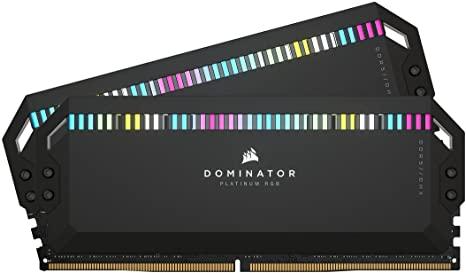
The Dominator Platinum series is CORSAIR’s flagship memory line, known for its premium construction and tight performance screening. This kit is built with a forged aluminum heatsink and features CORSAIR’s patented DHX cooling technology, which cools the memory ICs and the PCB itself.
Running at 6200 MT/s with CL36 timings, it is engineered for high-end Intel systems. Each module is equipped with 12 ultra-bright, individually addressable CAPELLIX RGB LEDs, which are controlled via CORSAIR’s iCUE software. This software also allows for custom XMP 3.0 profile saving directly to the modules.
- Module Type: 288 Pin Unbuffered DIMM
- Performance Profile: Intel XMP 3.0
- Heatsink: Forged Aluminum with DHX Cooling
- Ideal Use Case: Cost-is-no-object enthusiast builds and overclocking where premium aesthetics and build quality are paramount.
5. Gigabyte AORUS Memory DDR5
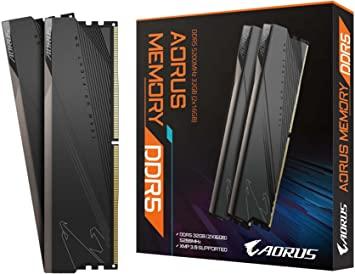
Gigabyte’s AORUS Memory enters the high-performance segment with a focus on thermal management. This kit utilizes a copper-aluminum composite heat spreader with a nanocarbon coating, designed for efficient heat dissipation under load.
The specifications of 6000 MT/s and CL36 timings are solid for modern gaming PCs. A notable feature is the “XMP 3.0 User Profile,” which allows users to create and save their own memory timing profiles within the BIOS of supported Gigabyte motherboards. This provides a level of customization for those who like to fine-tune their system’s performance.
- Module Type: 288 Pin Unbuffered DIMM
- Performance Profile: Intel XMP 3.0
- Heatsink: Copper-Aluminum Composite
- Ideal Use Case: Users building within the Gigabyte/AORUS ecosystem or those interested in advanced thermal solutions.
6. Crucial Pro DDR5

Note: The original product specified was a basic 4800MHz CL40 kit. The Crucial Pro series represents the current-generation enthusiast offering from the brand.
Crucial, a brand of Micron, is known for its no-nonsense approach to memory. The Crucial Pro DDR5 kit is designed for simplicity and broad compatibility. With a speed of 6000 MT/s and CL36 latency, it offers excellent performance for both work and play.
One of its key features is its out-of-the-box functionality. While it supports Intel XMP 3.0 and AMD EXPO for one-click performance, it can also downclock to operate at slower JEDEC standard speeds on systems that don’t support these profiles, ensuring maximum compatibility. The simple, black aluminum heat spreader is low-profile, making it a great fit for almost any build, including some of the best micro-ATX cases.
- Module Type: 288 Pin Unbuffered DIMM
- Performance Profile: Intel XMP 3.0 & AMD EXPO
- Heatsink: Low-Profile Aluminum
- Ideal Use Case: Mainstream users and system builders who need a universally compatible and reliable memory kit.
7. Lexar ARES RGB DDR5

The Lexar ARES RGB DDR5 kit is built for gamers and performance enthusiasts who need high bandwidth. The 6400 MT/s speed paired with a CL32 latency provides a tangible performance uplift in memory-sensitive applications and games.
The kit features a durable aluminum heat spreader to keep temperatures in check during demanding sessions. Its main draw is the vibrant RGB lighting, which can be synchronized with Lexar’s RGB Sync software as well as major motherboard lighting ecosystems. It also includes an on-die ECC and PMIC for enhanced reliability and power efficiency.
- Module Type: 288 Pin Unbuffered DIMM
- Performance Profile: Intel XMP 3.0 / AMD EXPO
- Heatsink: Aluminum
- Ideal Use Case: High-end gamers and performance seekers who also want customizable RGB aesthetics.
8. CORSAIR Vengeance DDR5
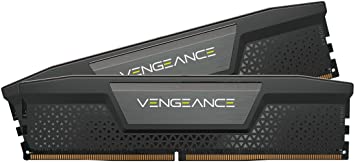
The CORSAIR Vengeance line has long been a go-to choice for performance-oriented builds, and the DDR5 version is no exception. The 6000 MT/s CL30 configuration is widely regarded by enthusiasts as the “sweet spot” for current-generation CPUs, offering an optimal balance of high frequency and low latency.
This kit delivers this performance in a clean, minimalist package with a solid aluminum heat spreader available in several colors. It is optimized for Intel motherboards and, like the Dominator series, allows for custom XMP 3.0 profiles to be saved directly to the module via iCUE software. Its slightly shorter profile compared to many RGB kits makes it a versatile choice. Before installation, it’s always wise to review what should be done prior to the installation of RAM onto the motherboard.
- Module Type: 288 Pin Unbuffered DIMM
- Performance Profile: Intel XMP 3.0
- Heatsink: Aluminum
- Ideal Use Case: Performance-focused users who want the optimal speed-to-latency ratio for gaming and productivity.
9. XPG Lancer Blade RGB DDR5
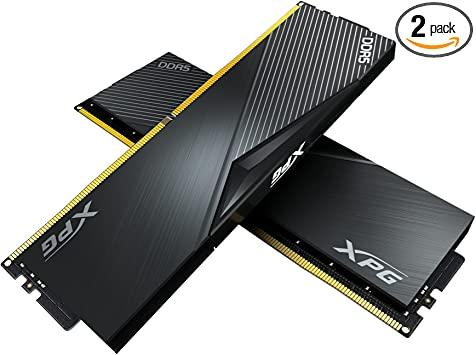
ADATA’s XPG Lancer Blade RGB is engineered to provide the benefits of both performance and RGB lighting in a compact form factor. Its low-profile heatsink stands at just 38.8mm tall, making it an excellent choice for Small Form Factor (SFF) builds or systems with bulky air coolers where clearance is tight.
Despite its smaller size, it delivers impressive 6000 MT/s CL30 performance. The customizable RGB light bar on top is compatible with software from all major motherboard brands. The combination of its performance profile and compact design makes it a highly versatile option.
- Module Type: 288 Pin Unbuffered DIMM
- Performance Profile: Intel XMP 3.0 / AMD EXPO
- Heatsink: Low-Profile Aluminum
- Ideal Use Case: SFF builders and users who need RGB memory that fits in space-constrained systems.
10. ADATA Premier DDR5

The ADATA Premier series represents the baseline for DDR5 memory. This 16GB module operates at the JEDEC standard of 4800 MT/s with a loose CL40 timing and a low 1.1V operating voltage. It does not feature a heat spreader and is not intended for overclocking or high-performance gaming.
Its purpose is to provide a stable, reliable memory solution for basic desktop PCs, office workstations, and systems where cost and power efficiency are the primary concerns. It includes an on-die ECC and a PMIC, which are standard across all DDR5 modules. While a single module will function, for tasks beyond basic use, a dual-module kit is necessary to enable dual-channel bandwidth.
- Module Type: 288 Pin Unbuffered DIMM
- Performance Profile: JEDEC Standard
- Heatsink: None
- Ideal Use Case: Entry-level PCs, non-gaming workstations, and system repairs or upgrades on a minimal budget.
Key Considerations for Selecting DDR5 RAM
Choosing the right DDR5 RAM involves more than just picking the fastest module. Understanding these key factors will ensure you select a kit that is compatible and provides the best performance for your specific system.
Speed vs. Latency: Finding the Performance Sweet Spot
- Speed: Measured in Megatransfers per second (MT/s), this indicates how many data transfers the RAM can perform per second. Higher is generally better, but not in isolation.
- Latency: CAS Latency (CL) is the number of clock cycles it takes for the RAM to respond to a data request. Lower is better.
True memory performance is a balance between these two metrics. A kit with extremely high speed but very high latency may not perform as well as a kit with moderately high speed and very low latency. For gaming builds, a speed of 6000 MT/s with a CAS Latency of CL30 or CL32 is widely considered the performance sweet spot, offering excellent results without the premium cost or potential instability of higher-frequency kits.
Capacity: How Much DDR5 RAM Do You Need?
- 16GB (2x8GB): The minimum recommended for modern gaming and general use. It is sufficient for most games but may become a bottleneck if you have many background applications open.
- 32GB (2x16GB): The current standard for gaming, streaming, and enthusiast PCs. This capacity provides ample headroom for demanding games, multitasking, and light content creation. It is a good idea to consider how much RAM to allocate to Minecraft and other specific applications.
- 64GB (2x32GB) or more: Primarily for professional content creators, video editors working with 4K/8K footage, 3D modelers, and users running complex virtual machines. For gaming, this capacity provides no tangible benefit over 32GB.
Intel XMP 3.0 vs. AMD EXPO: One-Click Performance
DDR5 RAM kits are rated for specific speeds and timings that are faster than the default JEDEC standard. To achieve these advertised speeds, you must enable a performance profile in your motherboard’s BIOS.
- Intel XMP (Extreme Memory Profile) 3.0: The standard for Intel platforms. It allows for up to five onboard profiles, including two that users can customize and save directly to the RAM modules.
- AMD EXPO (Extended Profiles for Overclocking): The standard for AMD’s AM5 platform. It is an open-source standard designed to provide stable, one-click overclocking for AMD Ryzen 7000 series CPUs and newer.
Many modern kits support both profiles, but it is essential to check the product page to ensure compatibility with your chosen CPU and motherboard.
Motherboard Compatibility and QVL
Blockquote: Before purchasing any RAM kit, it is critical to consult your motherboard’s Qualified Vendor List (QVL). This is a list of memory kits that the motherboard manufacturer has tested and verified for compatibility.
Using a kit not on the QVL does not guarantee it won’t work, but it significantly increases the risk of instability or failure to boot at its advertised XMP/EXPO profile. Checking the QVL is a crucial step when you are considering when you should upgrade your motherboard.
Physical Clearance: Heatsink Height and PC Case
Many high-performance RAM kits come with tall, elaborate heat spreaders for cooling and aesthetics. These can interfere with large CPU air coolers. Always check the height of the RAM module and the maximum CPU cooler height specification for your chosen PC case. If you are using a large air cooler or building in a compact case, a low-profile RAM kit like the T-Force Vulcan or XPG Lancer Blade is a safer choice.
Frequently Asked Questions
Is DDR5 a significant upgrade over DDR4 for gaming?
For new builds, DDR5 is the logical choice as it is supported by the latest CPU platforms from both Intel and AMD. While the immediate frame rate difference over high-end DDR4 can be modest in some titles, the higher bandwidth of DDR5 provides better performance in CPU-bound scenarios and offers more future-proofing as games become more demanding.
What is the current performance “sweet spot” for DDR5 RAM speed?
For most gaming and productivity tasks , a 32GB (2x16GB) kit rated at 6000 MT/s with a CAS Latency of CL30 or CL32 provides the best combination of performance, stability, and value.
Can I use four sticks of DDR5 RAM?
While motherboards have four RAM slots, running four sticks of DDR5 can be challenging for the memory controller on the CPU. This often results in the inability to run the RAM at its full rated XMP/EXPO speed. For optimal stability and performance, it is strongly recommended to use a two-module kit (e.g., 2x16GB for 32GB) to achieve your desired capacity.
Do I need to manually configure my DDR5 RAM in the BIOS?
Yes. Out of the box, all DDR5 RAM will run at a slower, default JEDEC standard speed. To reach the advertised speeds (e.g., 6000 MT/s), you must enter your motherboard’s BIOS and enable the corresponding Intel XMP or AMD EXPO profile. This is a simple, one-click process. To do this, you will first need to learn how to get into BIOS on an MSI motherboard or the equivalent for your specific brand.
Is it important to buy RAM as a kit?
Yes, it is highly recommended to purchase RAM as a single, factory-matched kit. Modules in a kit have been tested together to ensure they work at the advertised speeds and timings. Mixing and matching individual RAM sticks, even of the same model, can lead to system instability.

Holding a Ph.D. in Computer Science, Dr. Alistair Finch is our chief PC Component Benchmark Analyst. He provides meticulous, data-driven analysis of CPUs and GPUs, moving beyond marketing claims to reveal their true performance. His guides help readers understand the intricate relationship between hardware architecture and real-world gaming frame rates.
